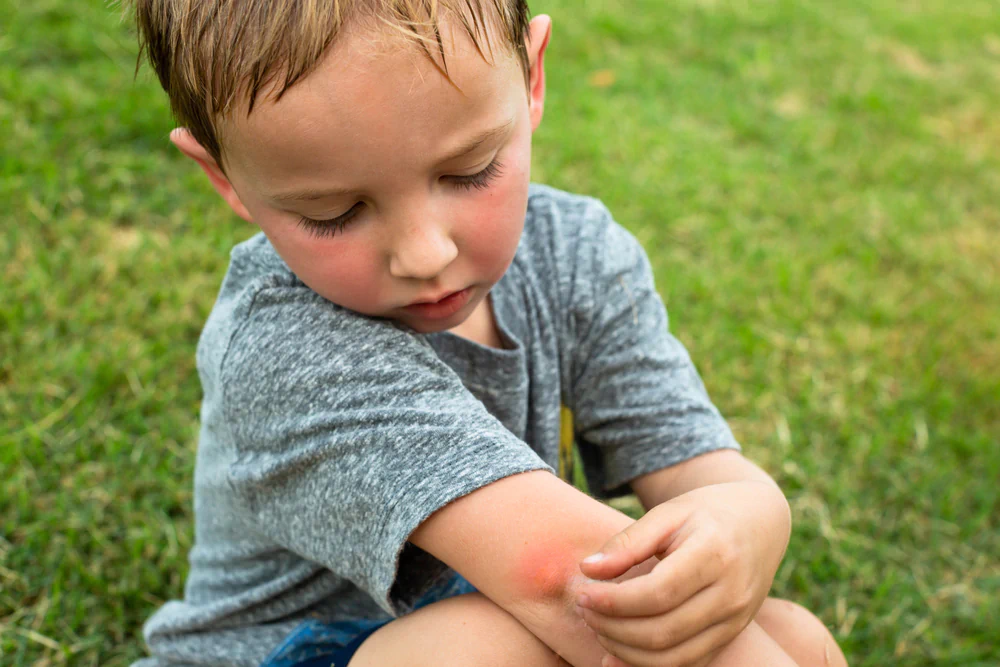How to Care For Insect Bites and Stings
Animal & Bug Bites
•
Jul 10, 2024
Reviewed by:

Insect bites and stings, although incredibly common, can cause a range of reactions, ranging from mild discomfort to severe allergic responses. Knowing how to properly care for these itchy and painful bumps can help you relieve symptoms and avoid any complications. Here’s a simple guide to help you manage insect bites and stings effectively:
- Clean the area: Gently wash the affected area with soap and water to reduce the risk of infection.
- Apply a cold compress: Use a cold pack or a cloth soaked in cold water to minimize swelling and numb the area.
- Safely use over-the-counter medications: Hydrocortisone cream or antihistamines can help reduce itching and inflammation.
- Avoid scratching: Scratching can worsen the irritation and increase the risk of infection.
- Monitor for signs of a severe reaction: Seek medical attention if you experience symptoms like difficulty breathing, swelling of the face or throat, or a widespread rash.
In this article, we’ll dive deeper into the types of insect bites and stings, their symptoms, and how to care for them.
How to get rid of bug bites: your care guide
Although how exactly to care for them can depend on the type of bug, having some general knowledge about bug bites and stings can go a long way in helping manage symptoms and ensuring proper treatment. Below, we explore each symptom in detail and provide specific care instructions.
1. Clean the area
Cleaning the affected area promptly is the first step in preventing infection. Gently wash the bite or sting with soap and water. This helps to remove any residual insect venom or bacteria. Use a mild soap to avoid additional irritation, and pat the area dry with a clean towel.
2. Apply a cold compress
Apply a cold compress to the bite or sting to minimize swelling and numb the pain. You can use a cold pack, an ice pack wrapped in a towel, or a cloth soaked in cold water. Apply the compress for about 15-20 minutes at a time, and repeat as necessary, ensuring you don’t place ice directly on the skin to prevent frostbite.
3. Safely use over-the-counter medications
Over-the-counter medications can significantly alleviate symptoms: applying hydrocortisone cream reduces itching and inflammation, and can provide relief from minor bites and stings; oral antihistamines can also be effective for allergic reactions, helping to reduce systemic itching, swelling, and rash. Follow the dosage instructions on the packaging or consult a pharmacist for advice, especially if you have any pharmaceutical allergies.
4. Avoid scratching
Scratching the bite or sting site can worsen irritation and lead to infection. Resisting the urge is crucial, even though the itch can be persistent. Keeping nails trimmed and applying anti-itch cream can help manage the discomfort. If the area is particularly itchy, using a bandage to cover it can prevent scratch-induced damage.
5. Monitor for signs of a severe reaction
In some cases, bug bites and stings can trigger severe allergic reactions, known as anaphylaxis. Symptoms of an allergic reaction to bug bites include:
- Difficulty breathing
- Swelling of the face or throat
- Dizziness
- Widespread rash or hives
These symptoms require immediate medical intervention. If you or someone else shows signs of a severe reaction, administer an epinephrine injection (EpiPen) if available, and seek emergency medical help.
When to go to the ER for insect bites and stings
Not all bites and stings necessitate a trip to the emergency room, but it’s essential to recognize when professional medical assistance is needed.
- If the swelling from a bite or sting spreads significantly, like when a leg or arm becomes very swollen, seek medical attention.
- If there is a red ring around the bug bite, redness, warmth, pus, or streaks of red, it is likely infected and needs to be treated by a healthcare professional.
- If the bug bite is bruising, it can indicate localized trauma or an adverse reaction to the bite. While bruising alone is not typically a cause for concern, it may still be advisable to monitor the area for any worsening symptoms or signs of infection.
- Persistent vomiting, diarrhea, or a high fever following an insect bite or sting could indicate a more serious systemic reaction or infection.
Remember, it’s always safest to seek professional medical advice if you’re unsure or if symptoms get worse. For people with health conditions like diabetes or immune system disorders, even a minor bite can become serious quickly, so it’s always best to be cautious.
Care considerations for different types of bites and stings
Knowing the different insect bites and stings types can help you identify and respond appropriately to each situation. If you’re wondering, “How can I tell what has bitten me?” below is a list of common bites and stings along with their typical symptoms and considerations:
| Symptoms | Considerations | |
| Mosquito Bites | Itchy, red bumps | Generally harmless, but can transmit diseases like malaria, dengue fever, and Zika virus |
| Bee Stings | Sharp pain, followed by swelling, redness, and warmth | Risk of severe allergic reaction (anaphylaxis); remove stinger promptly |
| Wasp Stings | Immediate pain, redness, and swelling | Can sting multiple times; higher risk of allergic reactions compared to bees |
| Tick Bites | Small red bump, sometimes leading to a bulls-eye rash (indicative of Lyme disease) | Can transmit Lyme disease and other tick-borne illnesses; remove ticks carefully and promptly |
| Flea Bites | Clusters of small, red bumps, often around ankles and lower legs | Extremely itchy; can transmit diseases like typhus |
| Spider Bites | Varies by species; can range from mild irritation to severe pain and necrosis | Some species, like the black widow and brown recluse, require medical attention immediately |
| Bed Bug Bites | Small red bumps, often in a line or cluster | Not known to transmit diseases, but can cause significant itching and discomfort |
| Ant Bites | Painful, itchy bumps, sometimes with pus-filled blisters | Fire ant bites can cause severe reactions and multiple stings |
| Chigger Bites | Intense itching, typically around the waist, ankles, or warm skin folds | No risk of disease transmission, but can cause severe itching and discomfort |
Learn the difference between a snake bite vs. spider bite.
Head to a Complete Care freestanding ER for all your bites and stings!
Dealing with insect bites and stings is an inevitable part of enjoying the outdoors — even if you’ve been following all of our summer and gardening safety tips — but with the right care, you can minimize their impact and get back to enjoying the warm weather.
Remember, if you or a loved one experiences a severe reaction or concerning symptoms (such as a severely inflamed bug bite), head to your nearest Complete Care freestanding emergency room for prompt and comprehensive care. Our experienced medical staff can provide the proper treatment and advice on how to prevent future bites and stings.
At Complete Care, our facilities are conveniently located to serve you and your family swiftly and efficiently. We have locations throughout Texas (Austin, Corpus Christi, Dallas/Fort Worth, East Texas, Lubbock, and San Antonio) and in Colorado Springs. No matter where you are, our team is ready to provide prompt emergency care for any insect bites, stings, or other urgent medical needs.
More Helpful Articles by Complete Care:
